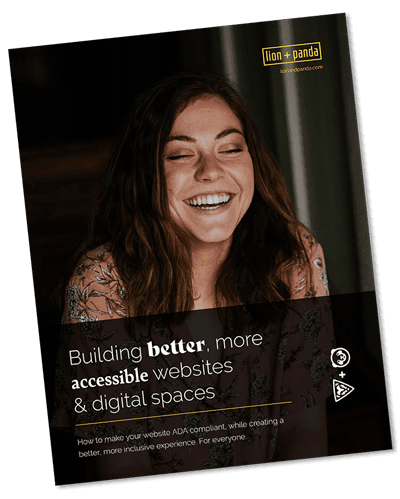Is Your Website
Accessible?
Build a more inclusive experience, broaden your audience and mitigate the risk for legal action.

1 in 5 Americans have some form of disability that makes experiencing your website more difficult.
Courts are now interpreting the Americans with Disabilities Act (ADA) to apply to digital spaces and online places of businesses as well. Does your website meet the WCAG 2.1 guidelines necessary to comply with the courts?
Is your website experience inclusive for those who may not be able to see, hear, read or otherwise experience your website the way you intended?
Having an accessible website:
- Builds a better experience.
- Complies with guidelines for commercial spaces under the Americans with Disabilities Act.
- Includes all users in how your website conveys information.
- Stays ahead of regulations and avoid opportunities for litigation.

Get our FREE guide to ADA and WCAG 2.1 compliance
Learn the basics about what guidelines apply to your business and what you should be doing to mitigate risk AND build a more inclusive experience.
How do you know if your website is Accessible?
If it’s news to you that the Americans with Disabilities Act has been interpreted by courts to apply to digital spaces and places of business as well, it will be comforting to you to know there are and abundance of recommendations and compliance guidelines for making your website not just user-friendly, but accessible to the 1 in 5 Americans with disabilities.
You may have some catching up to do!
But don’t fret! Making your website compliant doesn’t just reduce liabilities for your business, it also creates a web presence that is easier to use, appeals to search engines (meaning your website may rank higher!) and best of all, doesn’t just broaden your audience, makes your website a better experience for everyone.
Work with a partner
Working with a firm will ensure you are providing a human-centered user experience and provide the necessary depth to your auditing process. While automation tools exist to provide you with a surface-level overview of what your site may be missing, working with a team of professionals gives you a partner that does more than identify the areas that need to be addressed.
A team, like the one at Lion + Panda, can navigate your organization through the evolving compliance guidelines.

Get a human-powered audit and know where you stand
Avoid the trap of automated scans and take an experienced approach–one that is experienced, proven and gives you a more clear picture of what work needs to be completed to bring your website up to meet the guidelines. Understand your choices and proactively create a website that is inclusive and clear. To all audiences.
What happens if your website is not compliant?
If you have not considered making your website more accessible, you are leaving a portion of your audience out of the story. 20% of Americans have a disability that prevents them from experiencing your website the way you intended. Your business could also be vulnerable to legal action based on the interpretation of the Americans with Disabilities Act, which says commercial spaces must be accessible to the portion of the population with disabilities.
Don’t fall for free scans
and automated software.
If you are curious about why a human-centric approach is better, download our free guide to understand the ins and outs of ADA compliance.